Elucidation of Expression Patterns and Functional Properties of Archaerhodopsin Derived from Halorubrum sp. Ejinoor
Simple Summary
Abstract
1. Introduction
2. Materials and Methods
2.1. Expression and Purification of Bacteriorhodopsin Proteins
2.2. Size-Exclusion Chromatography (SEC) Analysis and CD Spectra
2.3. pH Titration and Absorption Spectra
2.4. Analysis by High Performance Liquid Chromatography of Isomeric Yellow Dye
2.5. Flash-Photolysis Analysis
2.6. Proton Translocation Kinetics and Intracellular ATP Quantification
2.7. Computational Characterization of HeAR
3. Results
3.1. Induction Expression and Purification of Photosensitive Proteins
3.2. SEC Elution Profile and Secondary Structure Characterization
3.3. Light and Dark Adaptation States and Composition of Visual Arrestin Isoforms
3.4. Photosensitive Protein Photochemical Reaction Cycle
3.5. Light-Driven Proton-ATP Metabolic Coupling Dynamics
3.6. Phylogenetic Tree and Amino Acid Conservation Profiling of Archaerhodopsins
3.7. AlphaFold Predicts Functional Microbial Rhodopsin Structures
3.8. Molecular Docking Analysis of HeAR and BR with All-Trans Retinal Using Alphafold-Predicted Structures
3.9. Molecular Dynamics Analysis
4. Discussion
4.1. Molecular Conformation and Structural Stability
4.2. Photodynamics and Optogenetic Adaptability
4.3. Functional Evolution and Cross-Species Comparison
4.4. Optogenetic Application Prospects
5. Conclusions
Author Contributions
Funding
Institutional Review Board Statement
Informed Consent Statement
Data Availability Statement
Conflicts of Interest
References
- Seyedkarimi, M.S.; Aramvash, A.; Ramezani, R. High production of bacteriorhodopsin from wild type Halobacterium salinarum. Extremophiles 2015, 19, 1021–1028. [Google Scholar]
- Noji, T.; Ishikita, H. Mechanism of Absorption Wavelength Shift of Bacteriorhodopsin During Photocycle. J. Phys. Chem. B 2022, 126, 9945–9955. [Google Scholar]
- Pan, Y.; Brown, L.; Konermann, L. Kinetic folding mechanism of an integral membrane protein examined by pulsed oxidative labeling and mass spectrometry. J. Mol. Biol. 2011, 410, 146–158. [Google Scholar]
- Kawanabe, A.; Furutani, Y.; Jung, K.H.; Kandori, H. Engineering an inward proton transport from a bacterial sensor rhodopsin. J. Am. Chem. Soc. 2009, 131, 16439–16444. [Google Scholar]
- Kawatake, S.; Umegawa, Y.; Matsuoka, S.; Murata, M.; Sonoyama, M. Evaluation of diacylphospholipids as boundary lipids for bacteriorhodopsin from structural and functional aspects. Biochim. Biophys. Acta 2016, 1858, 2106–2115. [Google Scholar] [CrossRef]
- Chen, Y.; Yeh, C.J.; Guo, Q.; Qi, Y.; Long, R.; Creton, C. Fast reversible isomerization of merocyanine as a tool to quantify stress history in elastomers. Chem. Sci. 2020, 12, 1693–1701. [Google Scholar]
- Johnson, T.J.; Gakhar, S.; Risbud, S.H.; Longo, M.L. Development and Characterization of Titanium Dioxide Gel with Encapsulated Bacteriorhodopsin for Hydrogen Production. Langmuir 2018, 34, 7488–7496. [Google Scholar] [CrossRef]
- Zhang, Y.; Li, K.; Zang, M.; Cheng, Y.; Qi, H. Graphene-based photocatalysts for degradation of organic pollution. Chemosphere 2023, 341, 140038. [Google Scholar] [CrossRef]
- Geldasa, F.T.; Kebede, M.A.; Shura, M.W.; Hone, F.G. Experimental and computational study of metal oxide nanoparticles for the photocatalytic degradation of organic pollutants: A review. RSC Adv. 2023, 13, 18404–18442. [Google Scholar]
- Vasu, D.; Fu, Y.; Keyan, A.K.; Sakthinathan, S.; Chiu, T.W. Environmental Remediation of Toxic Organic Pollutants Using Visible-Light-Activated Cu/La/CeO2/GO Nanocomposites. Materials 2021, 14, 6143. [Google Scholar] [CrossRef]
- Ding, M.; Ao, W.; Xu, H. Facile construction of dual heterojunction CoO@TiO2/MXene hybrid with efficient and stable catalytic activity for phenol degradation with peroxymonosulfate under visible light irradiation. J. Hazard. Mater. 2021, 42, 126686. [Google Scholar]
- Kawano, F.; Suzuki, H.; Furuya, A.; Sato, M. Engineered pairs of distinct photoswitches for optogenetic control of cellular proteins. Nat. Commun. 2015, 6, 6256. [Google Scholar]
- Repina, N.A.; Rosenbloom, A.; Mukherjee, A.; Schaffer, D.V.; Kane, R.S. At Light Speed: Advances in Optogenetic Systems for Regulating Cell Signaling and Behavior. Annu. Rev. Chem. Biomol. Eng. 2017, 8, 13–39. [Google Scholar] [PubMed]
- Vlasova, A.D.; Bukhalovich, S.M.; Bagaeva, D.F. Intracellular microbial rhodopsin-based optogenetics to control metabolism and cell signaling. Chem. Soc. Rev. 2024, 53, 3327–3349. [Google Scholar]
- Jeong, J.; Jung, J.; Jung, D. An implantable optogenetic stimulator wirelessly powered by flexible photovoltaics with near-infrared (NIR) light. Biosens. Bioelectron. 2021, 180, 113139. [Google Scholar]
- Vierock, J.; Rodriguez-Rozada, S.; Dieter, A. BiPOLES is an optogenetic tool developed for bidirectional dual-color control of neurons. Nat. Commun. 2021, 12, 4527. [Google Scholar]
- Amtul, Z.; Aziz, A.A. Microbial Proteins as Novel Industrial Biotechnology Hosts to Treat Epilepsy. Mol. Neurobiol. 2017, 54, 8211–8224. [Google Scholar] [PubMed]
- Ullrich, S.; Gueta, R.; Nagel, G. Degradation of channelopsin-2 in the absence of retinal and degradation resistance in certain mutants. Biol. Chem. 2013, 394, 271–280. [Google Scholar]
- Lemieux, C.; Otis, C.; Turmel, M. Ancestral chloroplast genome in Mesostigma viride reveals an early branch of green plant evolution. Nature 2000, 403, 649–652. [Google Scholar] [CrossRef]
- Zhang, F.; Prigge, M.; Beyrière, F. Red-shifted optogenetic excitation: A tool for fast neural control derived from Volvox carteri. Nat. Neurosci. 2008, 11, 631–633. [Google Scholar]
- DuBois, D.W.; Murchison, D.A.; Mahnke, A.H. Maintenance of optogenetic channel rhodopsin (ChR2) function in aging mice: Implications for pharmacological studies of inhibitory synaptic transmission, quantal content, and calcium homeostasis. Neuropharmacology 2023, 238, 109651. [Google Scholar] [CrossRef] [PubMed]
- Okhrimenko, I.S.; Kovalev, K.; Petrovskaya, L.E. Mirror proteorhodopsins. Commun. Chem. 2023, 6, 88. [Google Scholar] [CrossRef] [PubMed]
- Trachtová, S.; Spanová, A.; Horák, D.; Kozáková, H.; Rittich, B. Real-Time Polymerase Chain Reaction as a Tool for Evaluation of Magnetic Poly(Glycidyl methacrylate)-Based Microspheres in Molecular Diagnostics. Curr. Pharm. Des. 2016, 22, 639–646. [Google Scholar] [CrossRef]
- Yamada, M.; Okada, Y.; Yoshida, T.; Nagasawa, T. Vanillin production using Escherichia coli cells over-expressing isoeugenol monooxygenase of Pseudomonas putida. Biotechnol. Lett. 2008, 30, 665–670. [Google Scholar] [CrossRef]
- Cubizolle, A.; Cia, D.; Moine, E. Isopropyl-phloroglucinol-DHA protects outer retinal cells against lethal dose of all-trans-retinal. J. Cell Mol. Med. 2020, 24, 5057–5069. [Google Scholar] [CrossRef] [PubMed]
- Zhang, X.; Miller, K.W. Dodecyl maltopyranoside enabled purification of active human GABA type A receptors for deep and direct proteomic sequencing. Mol. Cell Proteom. 2015, 14, 724–738. [Google Scholar] [CrossRef]
- Wang, X.; Long, H.; Shen, D.; Liu, L. Cloning, expression, and characterization of a novel sialidase from Brevibacterium casei. Biotechnol. Appl. Biochem. 2017, 64, 195–200. [Google Scholar] [CrossRef]
- Ilgü, H.; Jeckelmann, J.M.; Gachet, M.S.; Boggavarapu, R.; Ucurum, Z.; Gertsch, J.; Fotiadis, D. Variation of the detergent-binding capacity and phospholipid content of membrane proteins when purified in different detergents. Biophys. J. 2014, 106, 1660–1670. [Google Scholar] [CrossRef]
- Goyon, A.; McDonald, D.; Fekete, S.; Guillarme, D.; Stella, C. Development of an innovative salt-mediated pH gradient cation exchange chromatography method for the characterization of therapeutic antibodies. J. Chromatogr. B Analyt Technol. Biomed. Life Sci. 2020, 1160, 122379. [Google Scholar] [CrossRef]
- Dai, G.; Geng, X. Photocycle of sensory rhodopsin II from Halobacterium salinarum (HsSRII): Mutation of D103 accelerates M decay and changes the decay pathway of a 13-cis O-like species. Photochem. Photobiol. 2018, 94, 705–714. [Google Scholar] [CrossRef]
- Chen, Z.; Tang, M.; Wang, Z. The Effects of Q-Switched Nd:YAG Laser Irradiation in the Wavelength of 1064nm and 532nm on Guinea Pigs’ Skin Tissue. Conf. Proc. IEEE Eng. Med. Biol. Soc. 2005, 2005, 6809–6812. [Google Scholar] [PubMed]
- Yan, B.; Cline, S.W.; Doolittle, W.F.; Spudich, J.L. Transformation of a bop-hop-sop-I-sop-II-Halobacterium halobium mutant to bop+: Effects of bacteriorhodopsin photoactivation on cellular proton fluxes and swimming behavior. Photochem. Photobiol. 1992, 56, 553–561. [Google Scholar] [CrossRef] [PubMed]
- Jumper, J.; Evans, R.; Pritzel, A.; Green, T.; Figurnov, M.; Ronneberger, O.; Tunyasuvunakool, K.; Bates, R.; Žídek, A.; Potapenko, A.; et al. Highly accurate protein structure prediction with AlphaFold. Nature 2021, 596, 583–589. [Google Scholar] [CrossRef]
- Pettersen, E.F.; Goddard, T.D.; Huang, C.C.; Meng, E.C.; Couch, G.S.; Croll, T.I.; Morris, J.H.; Ferrin, T.E. UCSF ChimeraX: Structure visualization for researchers, educators, and developers. Protein Sci. 2021, 30, 70–82. [Google Scholar] [CrossRef]
- Trott, O.; Olson, A.J. AutoDock Vina: Improving the speed and accuracy of docking with a new scoring function, efficient optimization, and multithreading. J. Comput. Chem. 2010, 31, 455–461. [Google Scholar] [CrossRef]
- Abraham, M.J.; Murtola, T.; Schulz, R.; Páll, S.; Smith, J.C.; Hess, B.; Lindahl, E. GROMACS: High performance molecular simulations through multi-level parallelism from laptops to supercomputers. SoftwareX 2015, 1–2, 19–25. [Google Scholar] [CrossRef]
- Maeda, A.; Iwasa, T.; Yoshizawa, T. Isomeric composition of retinal chromophore in dark-adapted bacteriorhodopsin. J. Biochem. 1977, 82, 1599–1604. [Google Scholar] [CrossRef] [PubMed]
- Balashov, S.P.; Imasheva, E.S.; Govindjee, R. Titration of aspartate-85 in bacteriorhodopsin: What it says about the proton pump mechanism. Biophys. J. 2005, 88, 2321–2329. [Google Scholar]
- Lanyi, J.K.; Schobert, B. Structural changes in the L photointermediate of bacteriorhodopsin. J. Mol. Biol. 2007, 365, 1379–1392. [Google Scholar] [CrossRef][Green Version]
- Lukashev, E.P.; Govindjee, R.; Kono, M.; Ebrey, T.G.; Sugiyama, Y.; Mukohata, Y. pH dependence of the absorption spectra and photochemical transformations of the archaerhodopsins. Photochem. Photobiol. 1994, 60, 69–75. [Google Scholar] [CrossRef]
- Balashov, S.P.; Imasheva, E.S.; Boichenko, V.A.; Antón, J.; Wang, J.M.; Lanyi, J.K. Xanthorhodopsin: A proton pump with a light-harvesting carotenoid antenna. Science 2005, 309, 2061–2064. [Google Scholar] [CrossRef] [PubMed]
- Oesterhelt, D.; Stoeckenius, W. Rhodopsin-like protein from the purple membrane of Halobacterium halobium. Nat. New Biol. 1971, 233, 149–152. [Google Scholar] [CrossRef]
- Hartmann, R.; Oesterhelt, D. Bacteriorhodopsin-mediated ATP synthesis in Halobacterium halobium. Eur. J. Biochem. 1977, 77, 325–335. [Google Scholar] [CrossRef]
- Zhang, L.; Wang, Y.; Li, Z.; Liu, C.; Zhou, H.; Guo, P. Functional characterization of Archaerhodopsin-4 from Halorubrum xinjiangense as a light-driven proton pump. Biochim. Biophys. Acta Biomembr. 2015, 1848, 2153–2161. [Google Scholar]
- Chaoluomeng, D.G.; Kikukawa, T.; Ihara, K.; Iwasa, T. Microbial rhodopsins of Halorubrum species isolated from Ejinoor salt lake in Inner Mongolia of China. Photochem. Photobiol. Sci. 2015, 14, 1974–1982. [Google Scholar] [CrossRef]
- Nakao, S.; Kojima, K.; Sudo, Y. Phototriggered Apoptotic Cell Death (PTA) Using the Light-Driven Outward Proton Pump Rhodopsin Archaerhodopsin-3. J. Am. Chem. Soc. 2022, 144, 3771–3775. [Google Scholar] [CrossRef]
- Herasymenko, K.; Walisinghe, D.; Konno, M.; Barneschi, L.; de Waele, I.; Sliwa, M.; Inoue, K.; Olivucci, M.; Haacke, S. Archaerhodopsin 3 is an ideal template for the engineering of highly fluorescent optogenetic reporters. Chem. Sci. 2024, 16, 761–774. [Google Scholar] [CrossRef] [PubMed]
- Bada Juarez, J.F.; Judge, P.J.; Adam, S.; Axford, D.; Vinals, J.; Birch, J.; Kwan, T.O.C.; Hoi, K.K.; Yen, H.Y.; Vial, A.; et al. Structures of the archaerhodopsin-3 transporter reveal that disordering of internal water networks underpins receptor sensitization. Nat. Commun. 2021, 12, 629. [Google Scholar] [CrossRef]
- Luecke, H.; Schobert, B.; Richter, H.-T.; Cartailler, J.-P.; Lanyi, J.K. Structure of bacteriorhodopsin at 1.55 Å resolution. J. Mol. Biol. 1999, 291, 899–911. [Google Scholar] [CrossRef]
- Matsui, Y.; Sakai, K.; Murakami, M.; Shiro, Y.; Adachi, S.; Okumura, H.; Kouyama, T. Specific damage induced by X-ray radiation and structural changes in the primary photoreaction of bacteriorhodopsin. J. Mol. Biol. 2002, 324, 469–481. [Google Scholar] [CrossRef]
- Ihara, K.; Umemura, T.; Katagiri, I.; Kitajima-Ihara, T.; Sugiyama, Y.; Kimura, Y.; Mukohata, Y. Evolution of the archaeal rhodopsins: Substitution rate and adaptive radiation. J. Mol. Evol. 1999, 48, 604–615. [Google Scholar]
- Henderson, R.; Baldwin, J.M.; Ceska, T.A.; Zemlin, F.; Beckmann, E.; Downing, K.H. Model for the structure of bacteriorhodopsin based on high-resolution electron cryo-microscopy. J. Mol. Biol. 1990, 213, 899–929. [Google Scholar] [CrossRef] [PubMed]
- Hess, B.; Kutzner, C.; van der Spoel, D.; Lindahl, E. GROMACS 4: Algorithms for Highly Efficient, Load-Balanced, and Scalable Molecular Simulation. J. Chem. Theory Comput. 2008, 4, 435–447. [Google Scholar] [CrossRef]
- Gradinaru, V.; Thompson, K.R.; Zhang, F.; Mogri, M.; Kay, K.; Schneider, M.B.; Deisseroth, K. Targeting and readout strategies for fast optical neural control in vitro and in vivo. J. Neurosci. 2007, 27, 14231–14238. [Google Scholar] [CrossRef] [PubMed]
- Sharma, A.K.; Spudich, J.L.; Doolittle, W.F. Phylogenetic analysis of halophilic archaea reveals horizontal transfer of rhodopsin genes. ISME J. 2012, 6, 441–451. [Google Scholar]
- Klapoetke, N.C.; Murata, Y.; Kim, S.S.; Pulver, S.R.; Birdsey-Benson, A.; Cho, Y.K.; Morimoto, T.K.; Chuong, A.S.; Carpenter, E.J.; Tian, Z.; et al. Independent optical excitation of distinct neural populations. Nat. Methods 2014, 11, 338–346. [Google Scholar] [CrossRef]
- Deisseroth, K. Optogenetics: 10 years of microbial opsins in neuroscience. Nat. Neurosci. 2015, 18, 1213–1225. [Google Scholar] [CrossRef]
- Romero, P.A.; Arnold, F.H. Exploring protein fitness landscapes by directed evolution. Nat. Rev. Mol. Cell Biol. 2009, 10, 866–876. [Google Scholar] [CrossRef]
- Berndt, A.; Lee, S.Y.; Ramakrishnan, C.; Deisseroth, K. Structure-guided transformation of channelrhodopsin into a light-activated chloride channel. Science 2014, 344, 420–424. [Google Scholar] [CrossRef]
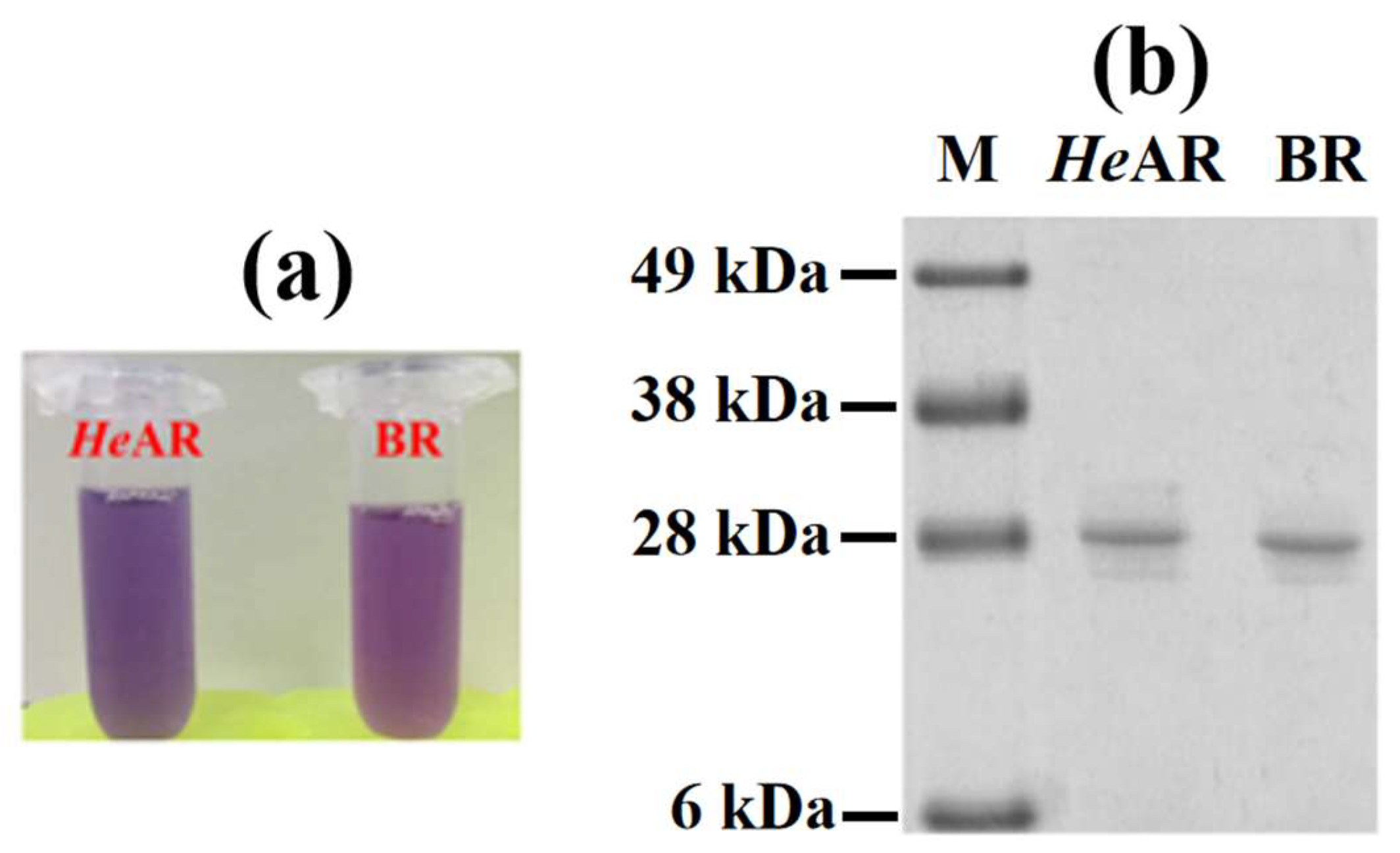
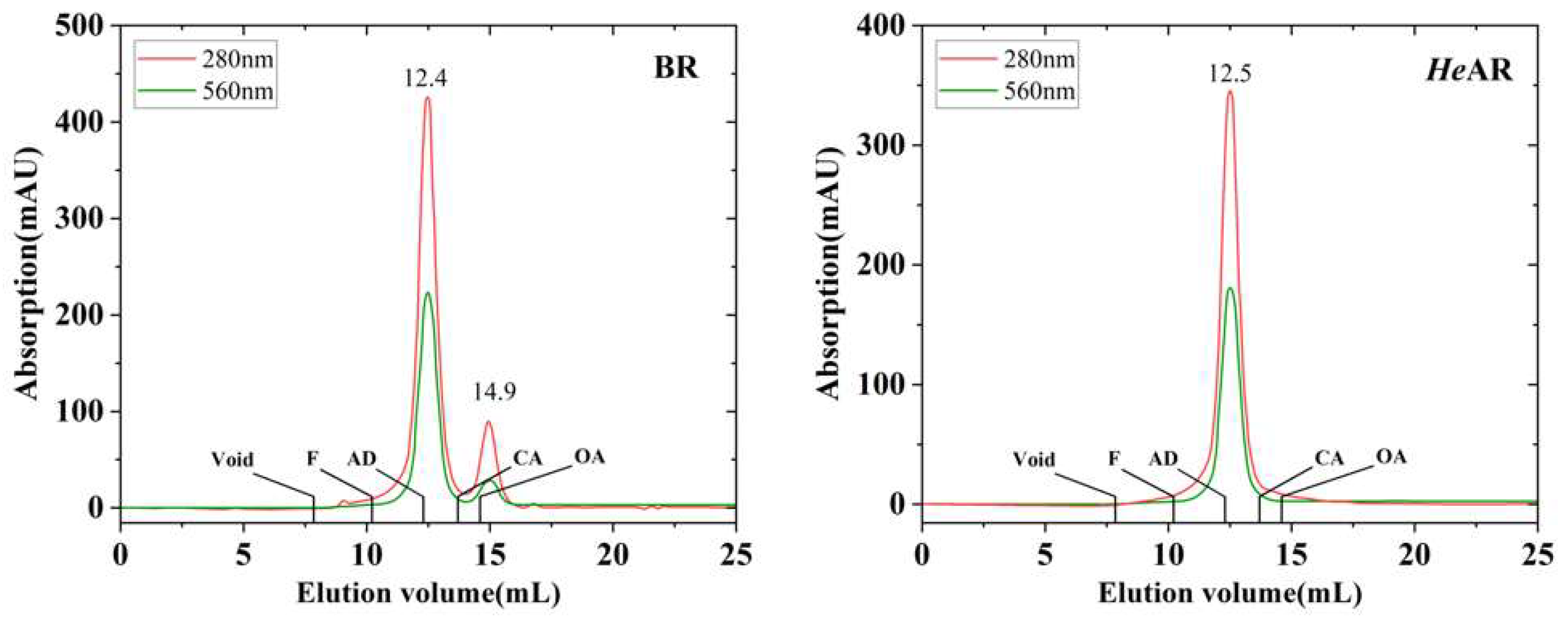
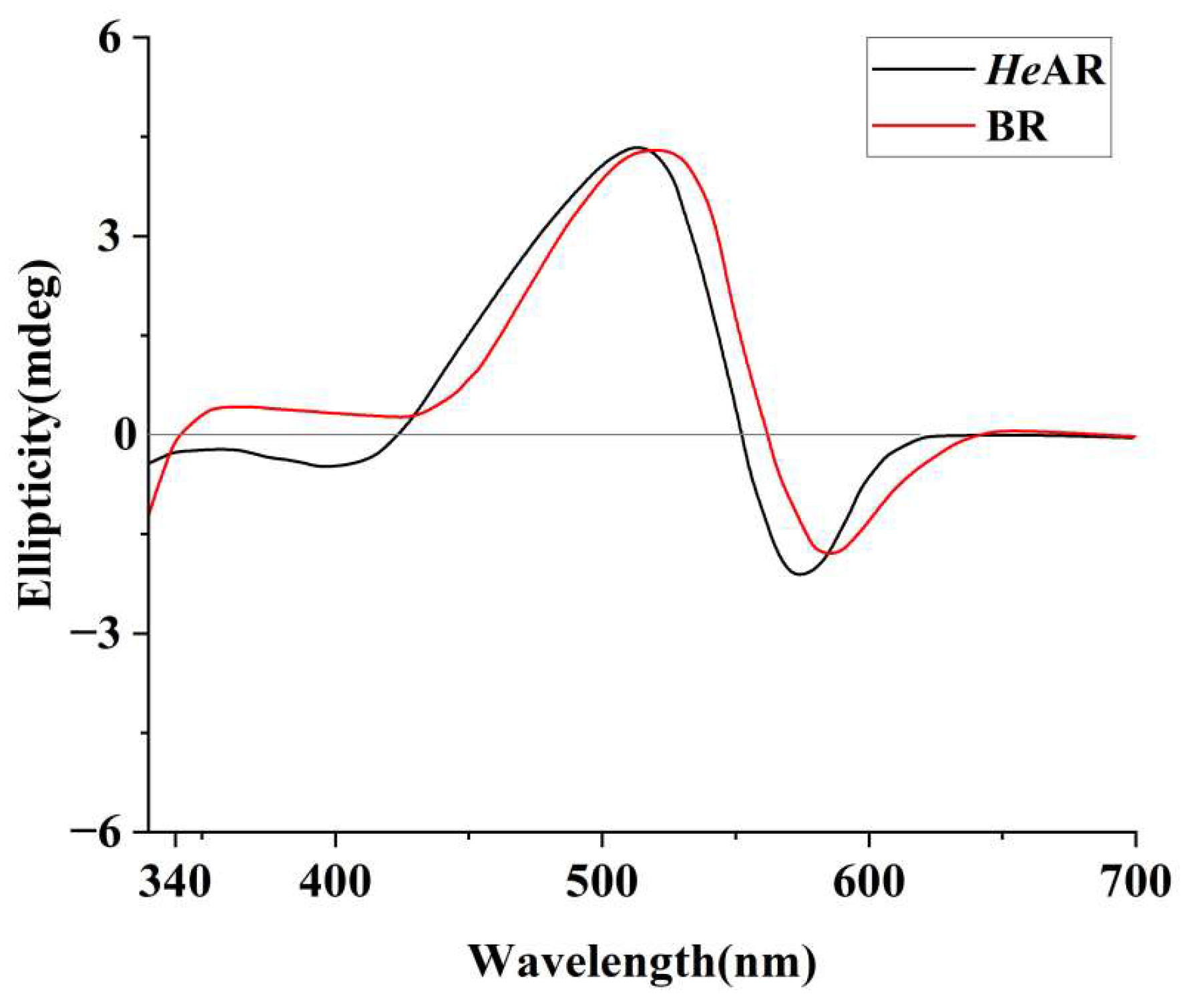


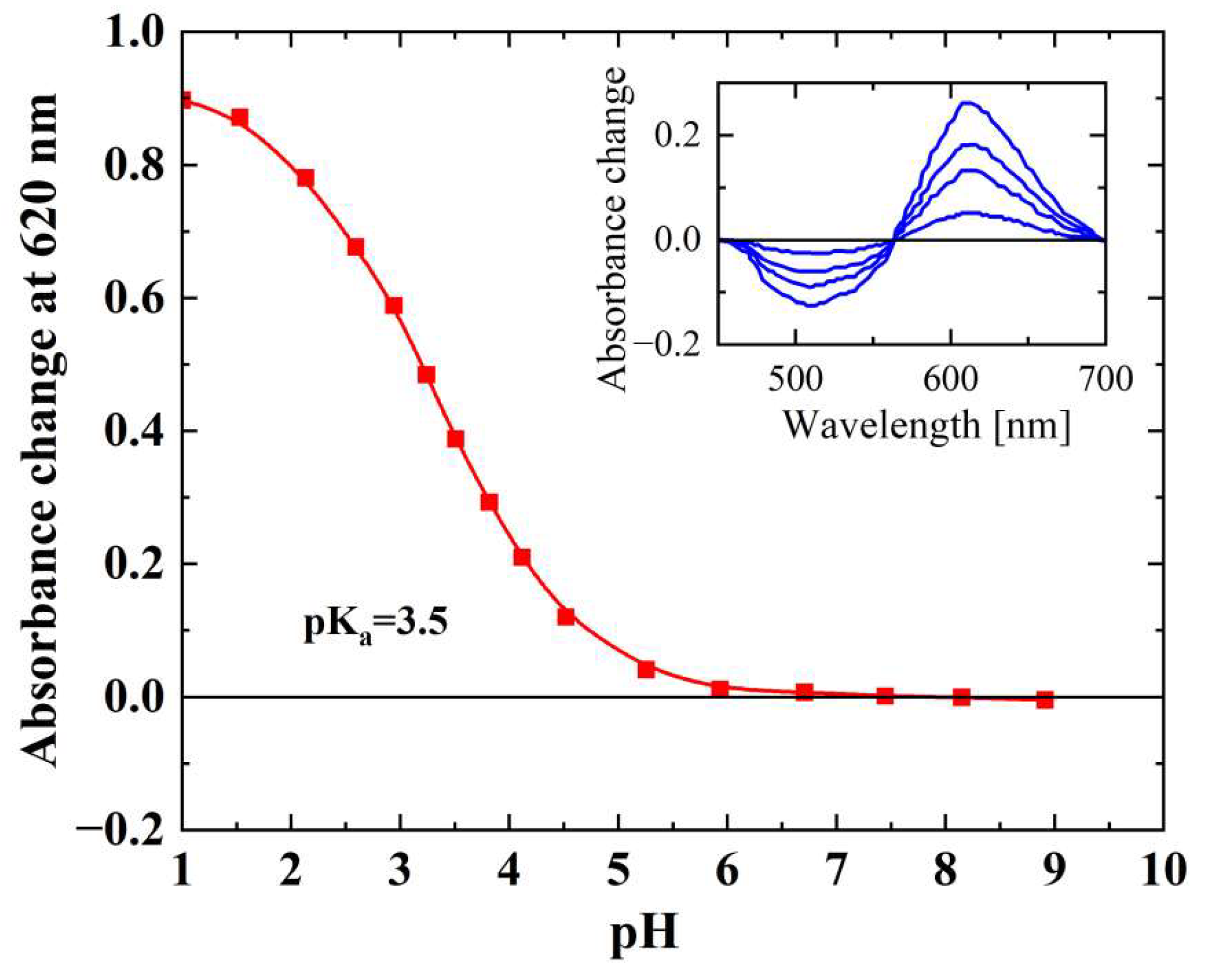
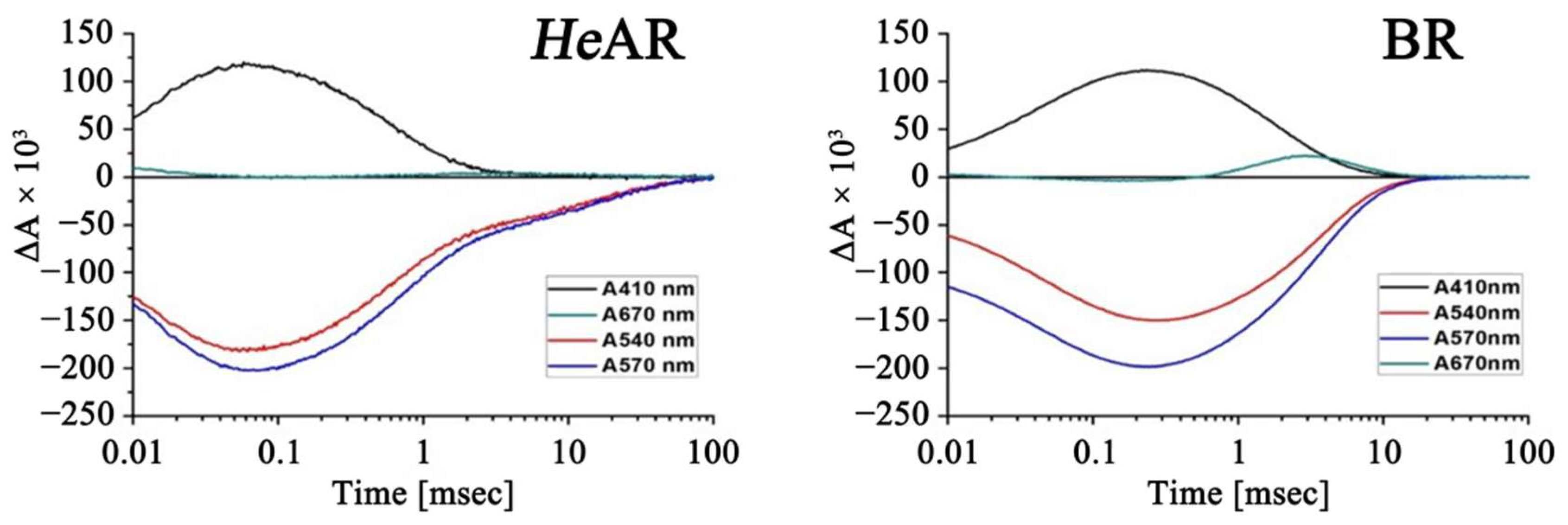
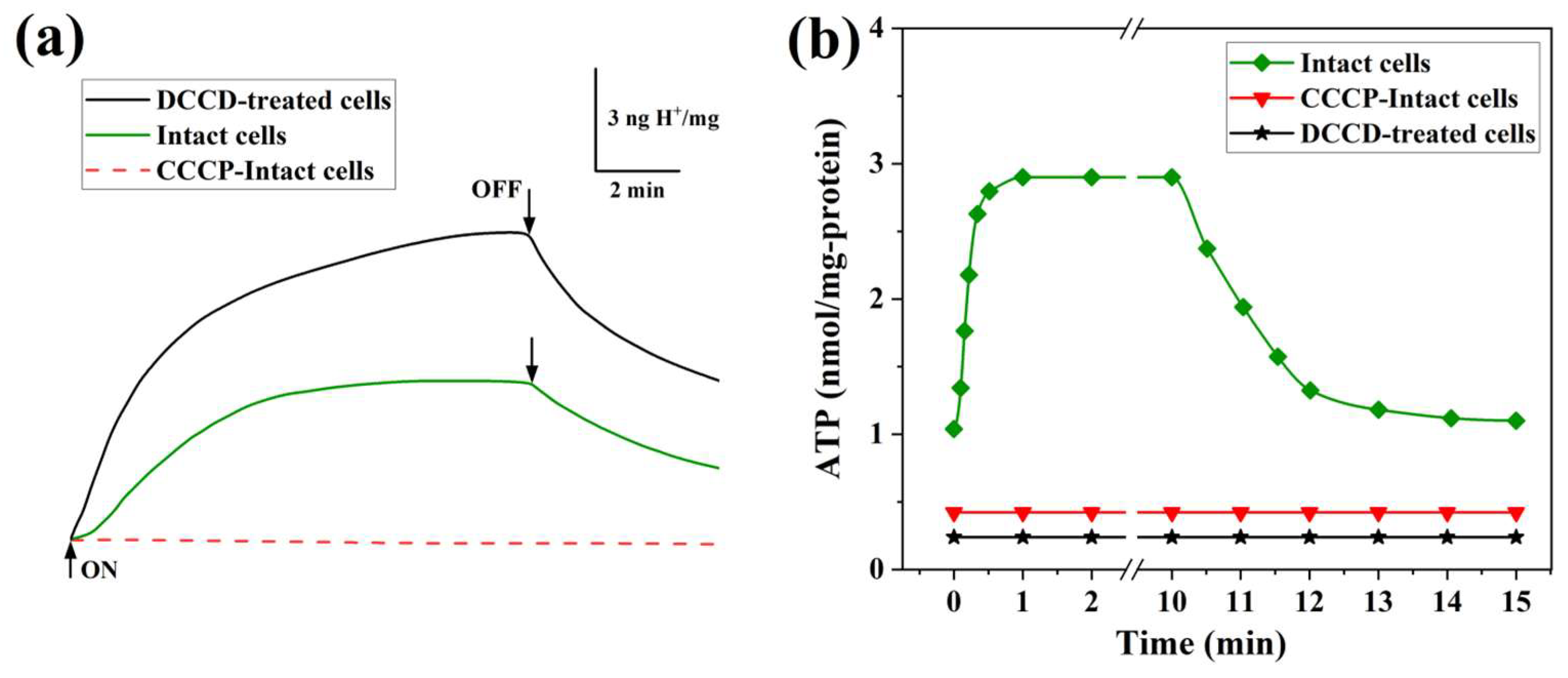


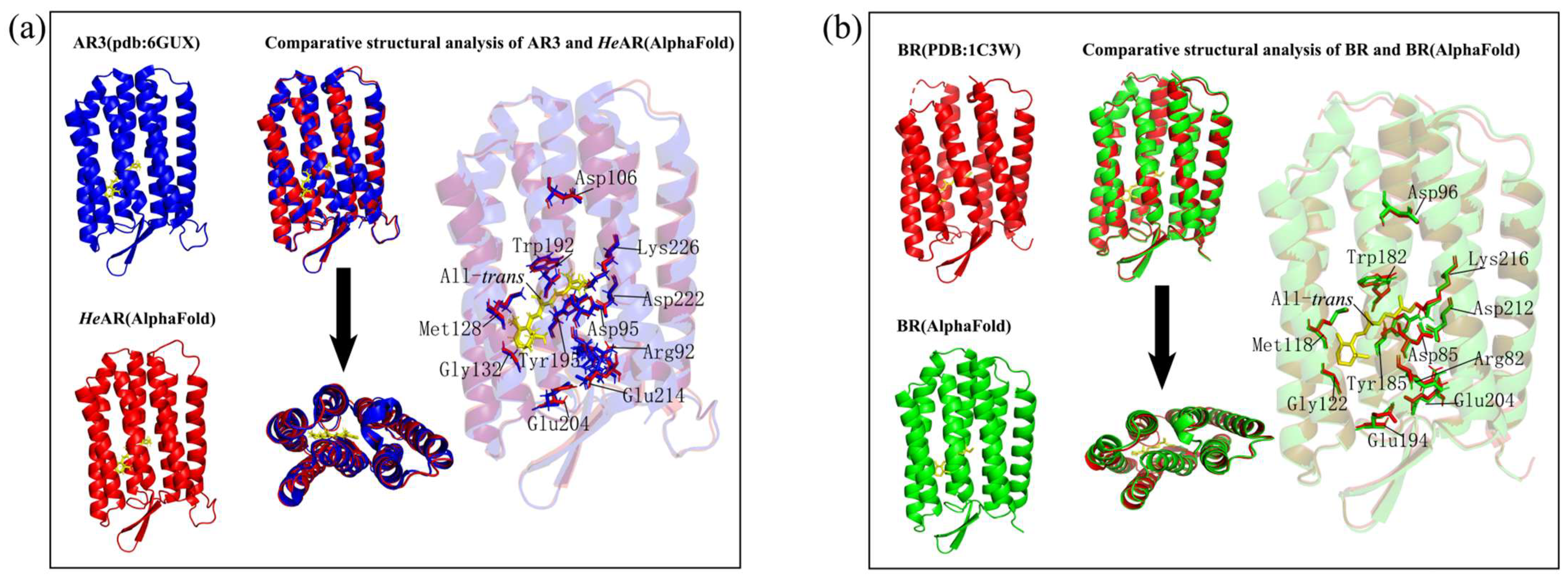
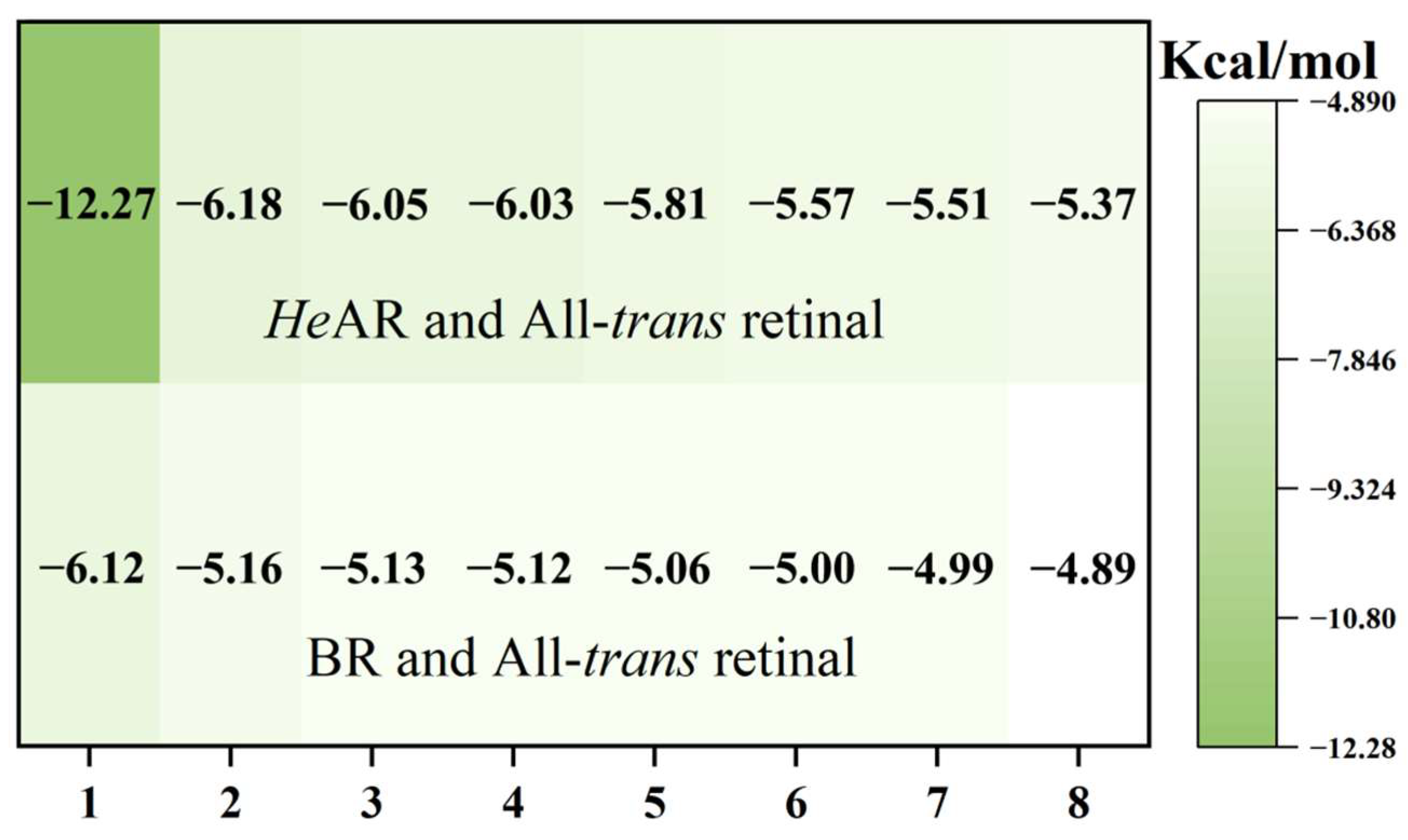
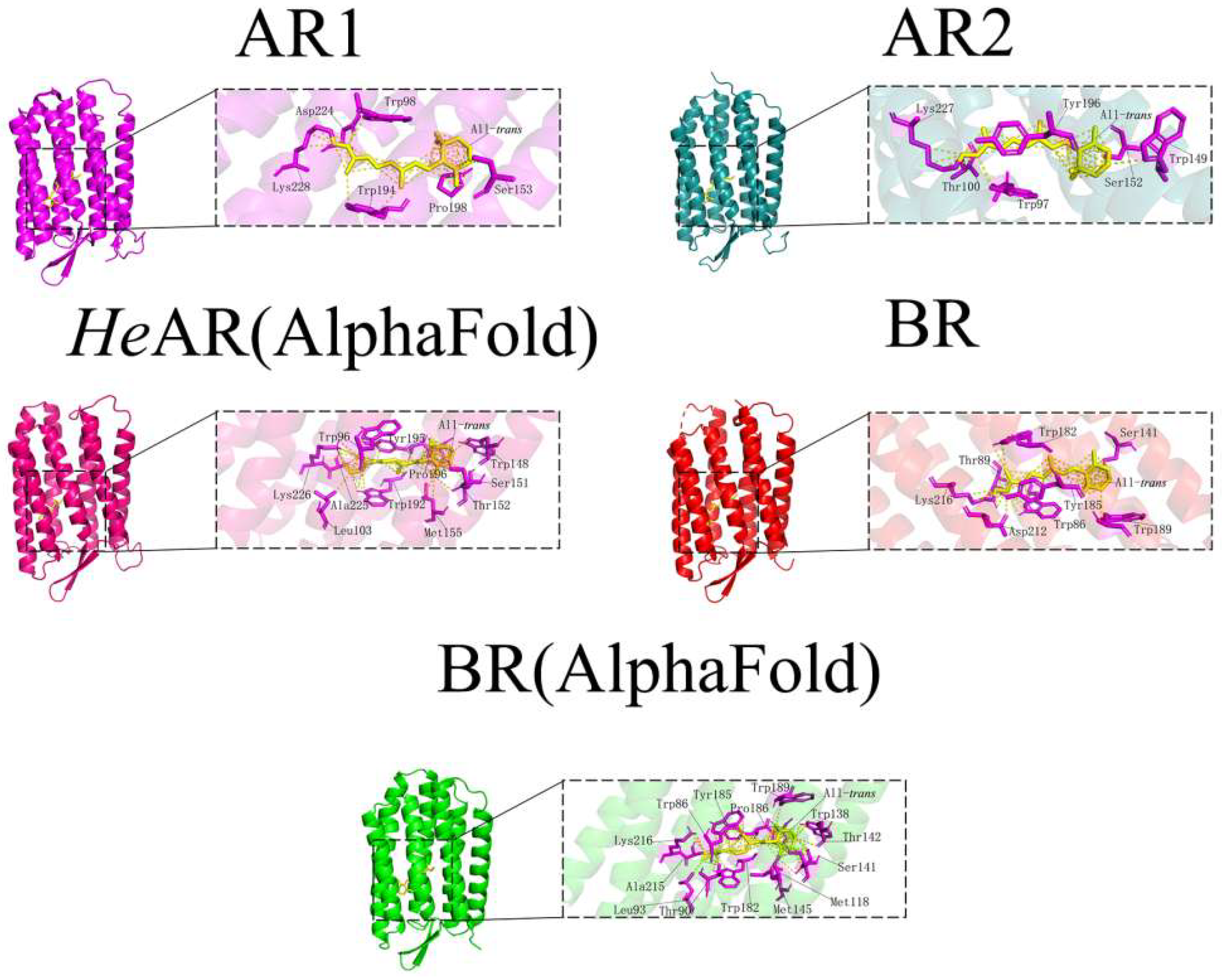
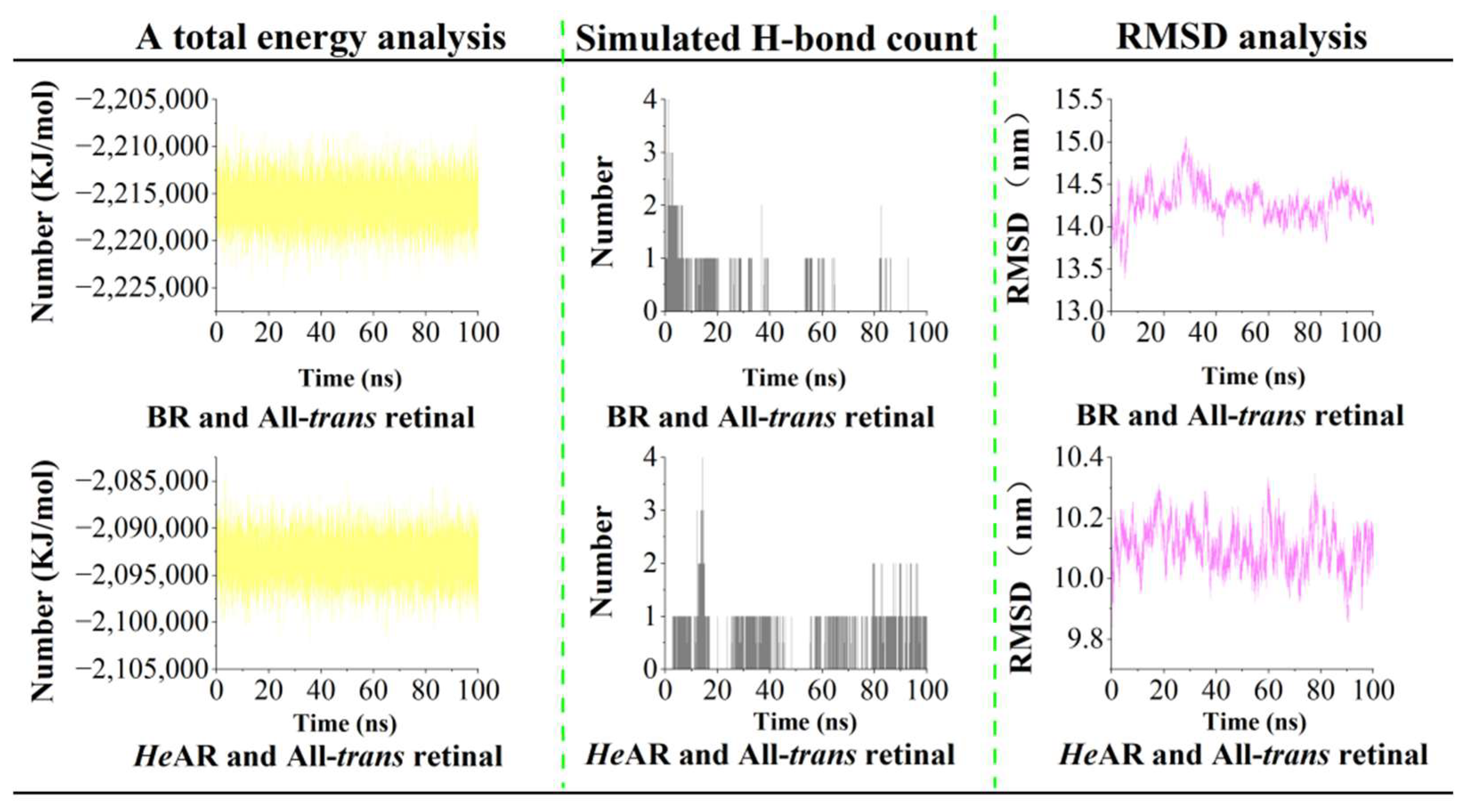

Disclaimer/Publisher’s Note: The statements, opinions and data contained in all publications are solely those of the individual author(s) and contributor(s) and not of MDPI and/or the editor(s). MDPI and/or the editor(s) disclaim responsibility for any injury to people or property resulting from any ideas, methods, instructions or products referred to in the content. |
© 2025 by the authors. Licensee MDPI, Basel, Switzerland. This article is an open access article distributed under the terms and conditions of the Creative Commons Attribution (CC BY) license (https://creativecommons.org/licenses/by/4.0/).
Share and Cite
Chao, L.; Yang, Y. Elucidation of Expression Patterns and Functional Properties of Archaerhodopsin Derived from Halorubrum sp. Ejinoor. Biology 2025, 14, 360. https://doi.org/10.3390/biology14040360
Chao L, Yang Y. Elucidation of Expression Patterns and Functional Properties of Archaerhodopsin Derived from Halorubrum sp. Ejinoor. Biology. 2025; 14(4):360. https://doi.org/10.3390/biology14040360
Chicago/Turabian StyleChao, Luomeng, and Yuxia Yang. 2025. "Elucidation of Expression Patterns and Functional Properties of Archaerhodopsin Derived from Halorubrum sp. Ejinoor" Biology 14, no. 4: 360. https://doi.org/10.3390/biology14040360
APA StyleChao, L., & Yang, Y. (2025). Elucidation of Expression Patterns and Functional Properties of Archaerhodopsin Derived from Halorubrum sp. Ejinoor. Biology, 14(4), 360. https://doi.org/10.3390/biology14040360





